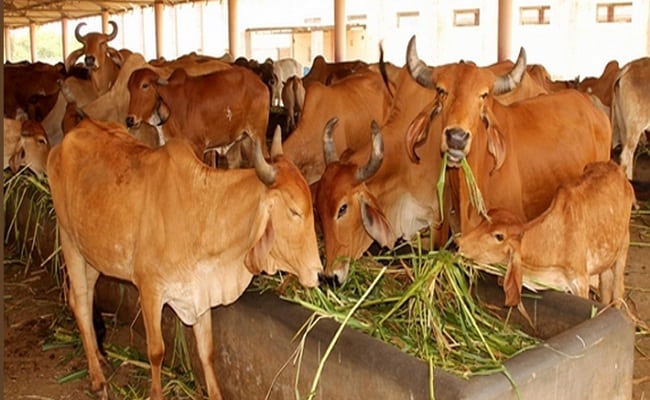
Harvesting Drought-Stressed or Damaged Crops as Forage for Livestock
Introduction
Due to climatic changes crop failures have become common across the country. The crop damages could occur due to drought, untimely heavy downpour or severe infestations. Crop failures cause heavy economic burden to farmers, even if the crop is insured. Large scale crop failure due to natural causes ultimately leads to an economic compensation package that ultimately drains the national economy. Nowadays in many countries failed crops are harvested to feed livestock, provided these meet certain quality and safety criteria. Stress due to drought is usually a major limitation of crop yields.
The main factor to consider when judging a crop for its suitability as fodder is its age. If the crop is mature, it can be converted into Hay Sun-dried fodder and fed to animals as dry fodder, whereas younger crop with a moisture content of 60-65% can be harvested and preserved as silage. The second point of consideration is whether any insecticide or fungicide has been used on the crop. In fact, in the case of pest-infested crops, farmers must consider the chances of salvaging the crop as livestock feed before spraying it with pesticides. If the chances are low, it would be in their favour to harvest the crop as cattle feed. If the crop has been sprayed with fungicide or insecticide, it can still be harvested as cattle feed in general after 14-21 days but better to follow appropriate holding time for the fungicide used.
Some soybean producers might be considering harvesting severely drought stressed soybean fields as forage this summer. This is not an easy decision and producers should consider the value of the soybean grain compared to the value of the soybean forage. Other considerations include the impact on crop insurance payments, federal disaster aid and feeding restrictions on all soybean pesticides. In India, soybean is cultivated over a large area.
Nutritive Values
In the event of crop failure, the farmers are always in dilemma and are confused if they should still wait for potential grain yield or salvage the crop for feeding to the livestock. As a general rule, if plants have retained more than 50 percent of their leaves, the crop has the potential to produce a good grain yield provided that significant rain occurs before these stop producing flowers. If more than 50 percent of the leaves have been lost, the plants have stopped producing flowers and only a few pods are present, the grain yield will be very low. In such situations, farmers would benefit from harvesting the soybean crop as livestock feed. A reasonable estimate of the dry matter yield of drought stressed soybean forage would be 1.5 tons per acre. Soybean can be harvested as fresh forage (and converted to silage) or hay.
The comparative nutritive value of these is given in the table below.
| Parameter | Forage (% DM) | Hay (% DM) | Straw (% DM) |
| Dry matter | 24.0 | 91.5 | 89.1 |
| Crude Protein | 15.7 | 15.9 | 6.9 |
| Crude Fibre | 31.2 | 33.8 | 44.2 |
| NDF | 48.1 | 47.0 | 79.7 |
| ADF | 37.2 | 34.9 | 59.9 |
| Ether Extract | 4.4 | 5.4 | 3.5 |
| M.E. MJ / KG |
Silage or Hay
It is preferable to harvest soybean forage as silage rather than bale it as dry hay since ensiling allows the organic dry matter to be retained during the harvest and storage. But if the crop is not suitable for silage production, good quality hay can be made provided the crop has plenty of leaves and the pods are tough enough to withstand the mowing and raking operations.
Ensiling drought stressed soybean crop
As with alfalfa and other fodder crops, soybeans should be allowed to wilt in the field till their moisture content is about 65% before chaffing. Determining the moisture content of the whole plant is critical to achieving proper fermentation. In case the moisture content is low, the crop can be soaked in water overnight and then chaffed to produce a 3/8-inch cut. The nutritional value of soybean silage is equivalent to that of alfalfa haylage. One downside is that soybean silage is less palatable than haylage or corn silage. Farmers should, therefore, ensure that soybean silage makes up only 15 to 20% of a daily ration since a higher percentage than this might inhibit the animal’s intake and thereby impede milk production. If the soybean crop is harvested at a stage when it has more seeds, and therefore a higher oil content, the silage quality will not be good as the oil will affect fermentation and palatability.
Feeding strategies
Soybean silage, when prepared from optimum quality fodder, is equal in nutritive values to alfa silage and this can be fed at the same rate. Hay tends to cause bloat in cattle, so it should be fed carefully and always mixed with grass hay or feed grass hay first followed by soybean hay. Soybean straw nutritive values are equal to other crop residues. Treating soybean straw with urea and alkali could be a good way to enhance its feeding value.
